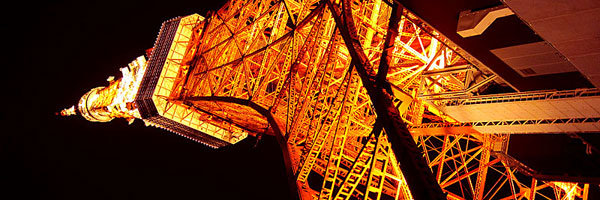 |
| Tokyo Tower |
Dominic Armato |
After a solid night's sleep (by which I mean five hours or so... hey, that's a good night!), it was back out bright and early to cover the portions of Ginza we hadn't gotten to on day one. We arrived at the subterranean entrance to the Matsuzakaya department store just a few minutes before opening, and the sight when we walked in the door is something I wish I'd photographed. The moment the doors opened, the entire staff of the food department -- no fewer than thirty of them immediately visible, though there were far, far more -- were at their stations, standing at attention, hands behind their backs, staring straight ahead and waiting for the customers to enter. It was downright military in its precision. Selling stuff this good is serious work.
|
|
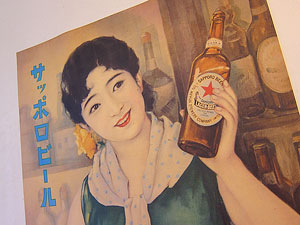 |
|
Old School |
Dominic Armato |
|
And when it came time for us to take a break from work and get some lunch, we decided to go old school. Seriously old school. Manpuku, just off the main drag in the heart of Ginza, has been around since the 1920s, and it serves up a bowl of shoyu ramen that's as close to ramen's Chinese origins as you're going to find in Japan. In fact, it isn't even a ramen shop so much as it is a small Chinese restaurant, serving all manner of stir fry dishes in addition to the ramen for which it's known. The place has character. It's old and spartan, white walls and wooden counters, with vintage replica posters and a even a few relics from the old days, including antique address plates and charred signage that no doubt survived some historic disaster. It's no mystery what we were getting here. I wanted one opportunity to get at the roots of ramen.
|
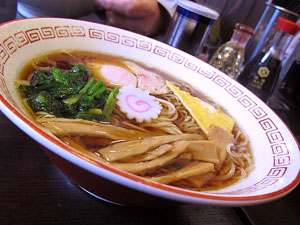 |
|
| Older School |
Dominic Armato |
|
That's Manpuku's bowl all over. This is classic Tokyo ramen, a clear chicken base accented with soy sauce. Some mix in a little dashi, but if such was the case here, I wasn't getting it. The noodles were thin and lightly kinked, and sitting on top were chopped greens (spinach?), fish cake, menma (fermented bamboo), a flat piece of scrambled egg omelet trimmed into a triangle, and a single thin slice of lean pork. Lean was really the operative word here, as classic Tokyo ramen is especially clean, refreshing and light, particularly when contrasted with the hordes of tonkotsu variations that dominate the scene today. And while I appreciate the history involved, if this is as exemplary a bowl of classic Tokyo ramen as Manpuku's reputation would suggest, I can't say that I count it among my favorites. The noodles struck me as weak, and not just because those at Gogyo the night before were so muscular. And the broth, though ably prepared, was skinny for my tastes. But not as skinny as the pork, which was in dire need of some fat. I guess what I'm saying is that while I appreciate Manpuku's ramen, it's easy to see why this style has fallen out of favor with the younger generation.
More shopping and researching and another 10-15 miles on the pedometer was followed by a little break before heading out to satisfy another obsession: Japanese curry. I've always loved the stuff, simply made from a dry powder, sweetened with onions and apples, thickened with a roux, smooth and mellow when compared to its fiery cousins from other nations. Japanese curry isn't challenging. It's comforting. And I'd read about a place in the base of Tokyo Tower called Tokyo Curry Lab that specializes in curry and operates under the theory (or at least the conceit) that they're a working "lab," constantly turning out new curry variations. Truthfully, I couldn't have cared less about the variations. I was after some old school thick, sweet Japanese curry. Off to Tokyo Tower.
|
|
 |
| No Argument Here |
Dominic Armato |
Tokyo Tower is a broadcast tower built in the '50s that's as much a tourist destination for its observation decks as it is a communications outfit. Think the Eiffel Tower, but taller and dayglo orange. Underneath the tower is FootTown, a kind of goofy little shopping and eating destination that I'm guessing is a little busier during the day than it is at 7:00 at night when we strolled up. Tokyo Curry Lab is tucked away into one corner of the mall, evoking a kind of 2001: A Space Odyssey vibe lightened up with corny humor. The counter and seats may be stark and geometric, but the placemats are covered with tongue-in-cheek graphics like this, and each seat has a small personal television showing... oy... Fever Pitch. Anyway, the curry was the goal, and while my father branched off and tried a couple of the more unusual concoctions (I must admit, the loco moco curry was mighty tempting), I stuck to the basics.
|
|
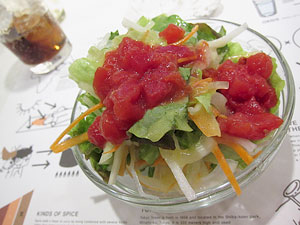 |
|
Salad with Tomato |
Dominic Armato |
|
The basics started with my oasis. You're not allowed to call it a glass of water, see? It's an oasis. Or so my placemat instructed me. Did I mention the place is a little goofy? In any case, I ordered a small salad with tomato. I'm a sucker for salads in Japan -- crisp greens and sweet dressings -- and I figured it'd be a nice start. This was a loooooooong way from Zakuro the day before, however (and to be fair, it was a miniscule fraction of the price). The salad consisted of a cup of mixed greens topped with chopped canned tomatoes. Now, I'm on record as a fan of canned tomatoes. Great canned tomatoes can be stupendous, and as an institution they've been unduly stigmatized. But who wants a fresh green salad with canned tomatoes? Could they not be bothered to stock fresh ones and had resorted to curry ingredients instead?
|
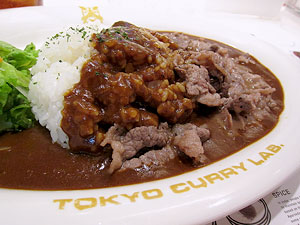 |
|
| Beef Curry |
Dominic Armato |
|
My father dug into an eggplant tomato curry -- yup, that's what I thought -- with which he was quite smitten, and I opted to stick with the basic beef curry. The plate arrived, stylishly branded, and I wish I could say I was enthused with what it bore. Though I've had better, the curry itself was lovely. They'd made it with a nice, deep roux, a good balance of spice and sweetness, and the sauce, though it really needed to be warmer, struck a solid, harmonious balance. The problem was that it wasn't a beef curry. It was curry poured over some beef. Limp, wet beef at that. A place that specialized in curry had managed to exemplify one of my biggest curry pet peeves. If you're going to cook a meat curry, cook the meat in the curry. The meat is enhanced by the curry. The curry is enhanced by the meat. With time to simmer, they marry to become a happy whole, one unified dish. But when done like this -- especially with beef this insipid -- it's a mess. Were they primarily a lunch spot that phoned it in after 3:00? Were they having financial troubles and cutting corners? Whatever the reason, it's a shame because there was a lot of potential in that recipe. Ironically, the hard part was done. They'd done a nice job of balancing the curry elements. It was lazy assembly that turned what could have been a really nice dish into a big disappointment.
|
|
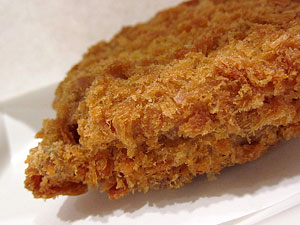 |
|
Curry Croquette |
Dominic Armato |
|
Thankfully, dinner number one (we'll, uh, get to that) wasn't a total loss. As a little lagniappe, I also ordered a curry croquette, and it pretty much saved the meal. Roughly the size and shape of a hockey puck, the croquette was coated with panko and fried to a deep golden brown. It had a really delicate, airy crispness, and the filling was an extra-thick curry sauce with an almost pudding-like consistency, that gently oozed out as I ate. It's certainly not something I'd make a point of returning for, but I found it delightful, and it kept the meal from being a total bust. And when visiting foreign locales for just a few days, few things are worse than meals that are a total bust. Leaving a now completely deserted Tokyo Tower, my father and I parted ways. He returned to the hotel, while I set out for Ebisu and dinner number two, with an old friend.
Dave's an old collegiate friend, though we didn't actually meet until the year after I left the college where he remained. I love to tell the story of how he taught himself Japanese by setting up CD players with phrasebooks on endless loop in every room of his apartment. Learning through osmosis, I guess. But far be it from me to question his methods, as he's now quite fluent, having spent the past five years living and working in Tokyo, and he's even married and settled into life there. At least as much as it's possible to settle into a place like Tokyo when your brain never gets a break from translation duties.
|
|
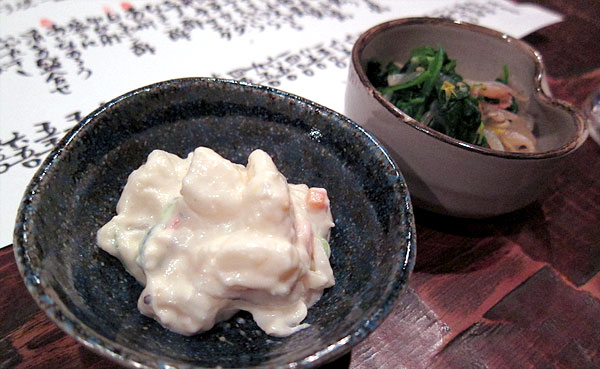 |
| Potato Salad, Tsukemono |
Dominic Armato |
No translation was necessary at our dinner destination, a fish-centered izakaya recommended by a Skillet Doux reader (thanks, Allison!) named Ippo, where the proprietor was a supremely friendly chap with excellent English skills. Though I always feel guilty forcing somebody to speak my language rather than the other way around, it was nice not to have to resort to point and stammer for a while. Not that it would have mattered where we ended up, given that I was in Dave's company. In some ways, I feel as though I should have dragged him to someplace more challenging to somebody who doesn't speak the language. But in any case, by the time I'd arrived (late... still learning the Tokyo subway system), Dave was nearing the end of his first shochu and happily bantering with the fellow behind the bar.
|
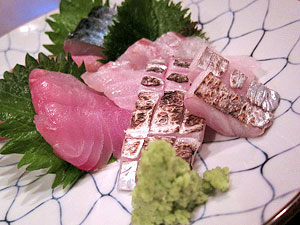 |
|
| Sashimi |
Dominic Armato |
|
Ippo's a second floor dive, and I use that term lovingly as it's a spartan, well-managed dive with some really good food, but it's humbly assembled and its charm is in the energy of its boisterous patrons, not the paint on the walls or the finish of the floor. I confess, the details of our meal at Ippo are a little hazy, not because of the shochu (though I partook a little), but because I was far more intent on catching up with a fine fellow whom I hadn't seen in far too long. But we sampled some fine fish while I learned all about his time in Japan. We started with some simple tsukemono, the random house pickles that precede so many meals in Japan, and a bowl of sweet and creamy potato salad. One thing I love, even if I've never understood it, is the Japanese love for mayonnaise. It's everywhere. And when they use it, they don't do so sparingly. I'm a mayo fiend myself, I have a special love for Kewpie, and it's yet another source of the kinship I feel with Japan. I realize that as cultural connections go this one's rather tenuous, but I'll take what I can get... don't take this one away from me.
|
|
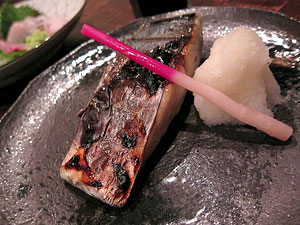 |
|
Miso Marinated... Fish |
Dominic Armato |
|
I don't remember who ordered what, but when food started arriving it kicked off with a delicious plate of sashimi, the specific varieties of which have all long escaped my memory, all cool and pristine and served atop shiso leaves with freshly grated wasabi. When we went hot, we moved onto a dish that will no doubt look familiar to fans of Nobu. Though he's made a name for himself with a dish that, admittedly, strikes a kind of magical balance, the roots of his version are in simple Japanese izakaya fare, where fillets of all stripes get the miso treatment before being slapped on the grill. I don't recall what manner of fish this was, but it was sparingly accented by the miso, simpler and far less sweet than the Nobu clones that now dot the landscape in the states, in no small part because the fish was dynamite and didn't need much.
|
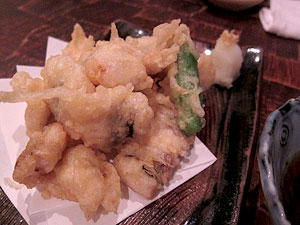 |
|
| Tempura Eel |
Dominic Armato |
|
I love eel. I've loved eel since the first time I tasted it. And it's possible this was the first time I'd had tempura fried eel. I think there might've been a vegetable or two mixed in there -- focusing on the conversation, remember -- but mostly eel, and it was really delicious. I can't say there was anything terribly revolutionary about the tempura. It was light, crisp and delicious, not too oily... everything you look for in a good tempura. What set it apart was simply the quality of the eel within. This wasn't the bad eel back home that's tough and dry. This wasn't even the good eel back home that's light and moist. This was eel of a freshness that would seem completely unattainable at home, almost creamy in places. And it wasn't even the best eel I'd end up having on this trip.
|
|
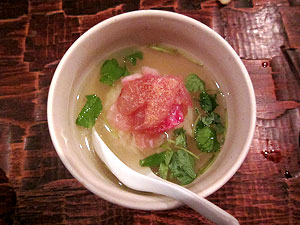 |
|
Ochazuke |
Dominic Armato |
|
There's something really beautiful about ochazuke. Food doesn't get much more humble than this. It's a kind of soulful, satisfying dish, little more than steamed rice swimming in dashi. Ippo's version goes so far as to add a tangle of fresh sashimi -- snapper, perhaps? -- and a few cilantro leaves. It was a great finish, and put a thematic cap on dinner at Ippo. Like Nakamenoteppen, this was very simple food, served in a comfortable and boisterous room, and its quality was almost completely derived from the quality of the ingredients that went into it. Good food, good drink, good people... this is why izakayas seem to be catching on back home. Of course, the refined end of the spectrum is what's cemented Japanese cuisine's place as one of the world's most compelling, but as long as we're in the midst of a comfort food boom, why not the comfort foods of other nations?
|
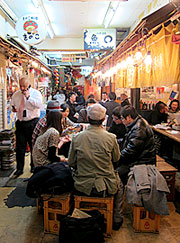 |
|
| Ebisu Yokocho |
Dominic Armato |
|
As we wound up our meal at Ippo, Dave suggested that he'd be willing to take me for an even more typical post-work hangout experience, and you know I certainly wasn't going to say no to dinner number three. We descended the stairs, took to the street, and strolled along at a brisk clip, making our way through the neighborhood, which was still hopping, even at 11:00 PM on a school night. We were still chatting away, him telling me all about living in Japan, me being insanely jealous and trying to plot my family's exodus to the Far East, when Dave suddenly stopped dead in his tracks like a pointer who'd picked up the scent. He turned around a few times, as though getting his bearings, before spinning to face a narrow, unmarked doorway that had been right next to us the whole time. I'm still unsure whether he was having trouble locating the place he'd visited many times before, or if this whole ritual was for show, but when we squeezed through the doorway what I found on the other side was a kind of Blade Runner scene, like a narrow alley filled with street food, except that it wasn't a street. We'd arrived at Ebisu Yokocho, a score of small food stalls lining the walls of an indoor "alley," stools and milk crates and makeshift tables spilling into the narrow aisle.
|
|
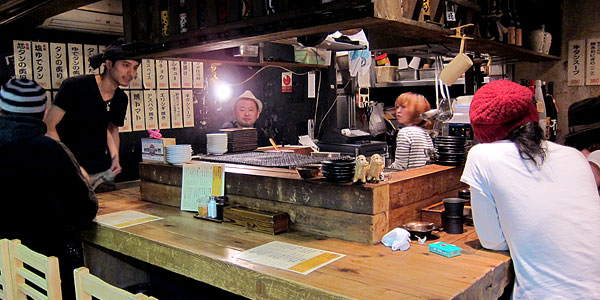 |
| Bekohira |
Dominic Armato |
The place was jammed with people eating and drinking and generally having what seemed to be an excellent time, and after slowly squeezing our way through the mayhem, Dave finally led me to an eight seat counter with a small grill, and we settled in, ordered a couple of beers, and took in the energy of the place. Clearly, Dave hasn't been reading the blog.
"Um... are you okay with beef tongue?"
"Dave, if you're trying to scare me, you're going to have to do a lot better than that."
At first, I thought he was referring to a specific dish he wanted to get. But I'd soon learn that we'd landed at Bekohira, a stand that deals almost exclusively in beef tongue. I almost feel like I should repeat that, it makes me downright giddy. Do less, do it better, indeed, limiting yourself to a single cut.
|
|
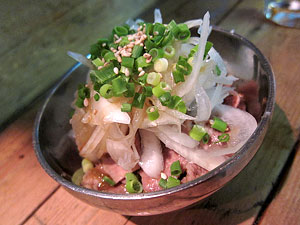 |
|
Ponzu Beef Tongue |
Dominic Armato |
|
It wasn't long before our first taste of tongue hit the counter. It was a cold dish, chilled, sliced beef tongue bathed in ponzu and topped with slivered onions, chopped chives and toasted sesame. This certainly isn't the first culture to lend a tart, pickled flavor to beef tongue, but what a crisp, clean variant this was. The tongue was sliced thin enough that it came apart readily, while still maintaining some significant chew. We're not hiding the meat's provenance, here... we're embracing it. Tart, citrusy ponzu, spicy raw onion and a little hint of sweetness, everything served ice cold in a small stainless steel bowl, it was like a chewy, meaty pickle and I was already loving this place.
|
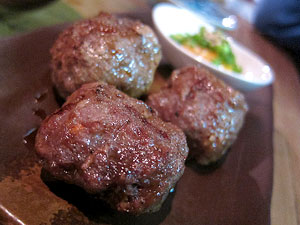 |
|
| Beef Tongue Tsukune |
Dominic Armato |
|
I'm not sure who spied the beef tongue tsukune first, me or Dave, but you know I jumped all over that one. How often do you have the chance to sample chicken and beef tongue tsukune on consecutive nights? It was composed much the same way as chicken tsukune, and similarly served with an egg yolk. But this was like tsukune on steroids, and I use the turn of phrase in a more literal fashion than it's usually intended. This was a truly muscular tsukune, big and beefy with serious chew, but ground finely enough that it yielded and avoided getting too tough. These were like robust, chewy meatballs, an unusually intense flavor coming from a grossly underused cut with big flavor. In retrospect, it seems so obvious. Why have I never seen this before?
|
|
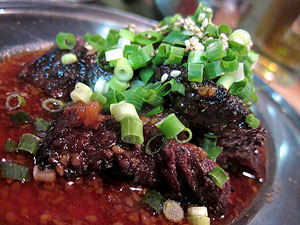 |
|
Grilled Beef Tongue |
Dominic Armato |
|
Our last dish brought some serious sweetness as well as a healthy dose of char to the counter. It was more tongue, this time marinated in some sort of sweet glaze, trimmed in an unusual manner that was almost feathered, leaving all sorts of nooks and crannies in the thick batons of meat. This had the effect of creating a wackyload or edges for the flame to attack, and this tongue was heavily charred on the edges before being dressed with a sweet soy-based sauce that I could probably describe with more eloquence if this weren't now dish three of dinner number three. I don't know what it was. I just know that it made me wish I could get tongue like this back home. At this point, it was well past midnight -- a school night for Dave, no less -- so we reluctantly resolved to call it a night and go our separate ways, until one of us should cross the Pacific again. Indeed, the only thing better than catching up with good people is when it's over good food. I wish we'd had more time.
Words to the wise: Why they operate this way in such a huge city where so many are dependent on public transportation, I have no idea. But staying out past 12:30 or so means a very expensive cab ride, as the Tokyo Metro shuts down for the 4-5 hours when late night revelers are most likely to be stumbling home. Perhaps it's an effort to curb hooliganism (because, you know, that's rampant in Japan </sarcasm>). More likely, I suspect, the taxi drivers are a strong lobby. In any case, it probably wasn't such a bad thing that I was forced to call it a night. It may have saved me from dinner number four.
| Manpuku |
| Tokyo-to, Chuo-ku |
| Ginza 2-13-13 |
| 3541-7210 |
| Mon - Sun |
11:30 AM - 10:30 PM |
|
|
| Tokyo Curry Lab |
| www.tokyocurrylab.jp |
| Tokyo Tower |
| Tokyo-to, Minato-ku |
| Shibakoen 4-2-8 |
| 5425-2900 |
| Mon - Sat |
11 AM - 9:20 PM |
|
| Bekohira |
| www.ebisu-yokocho.com |
| Ebisu Yokocho |
| Tokyo-to, Shibuya-ku |
| Ebisu 1-7-4 |
| 3445-4118 |
| Mon - Sat |
5 PM - 5 AM |
|


















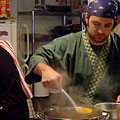
Two thoughts:
1) I love your taxi-drivers-lobby theory, because that was the same theory I had in Boston (where the T stops at 12:30 but bars stay open until 2). My friends at the time laughed it off but I was so convinced it must be the taxi drivers' doing! So I'm glad to see someone else with the same idea.
2) THERE IS A RESTAURANT DEDICATED TO TONGUE??? That's it. I need to go to Tokyo NOW. Seriously, all three of those dishes look fabulous and tongue is my favorite not-really-mainstream cut of meat. Heck, it might be my favorite cut of meat period. I don't actually know if/when I'll ever make it to Japan, but this post will be bookmarked until that day!
Posted by: Joanna | February 21, 2012 at 02:16 PM